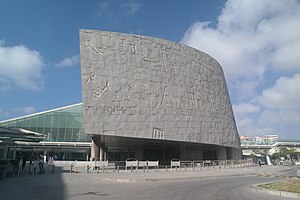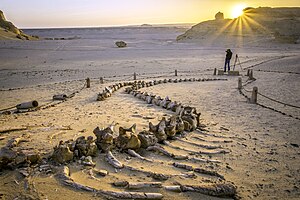Lower Egypt (Arabic: دلتا مصر delta màSr) is the northern part of Egypt, containing the Nile Delta, Cairo and Alexandria. It's not a defined region or province, just a convenient grouping for travel purposes, and with a high proportion of Egypt's top sights.
Cities[edit]
- 1 Cairo is the maddening, magnificent, must-see national capital, firmly attached to the past yet home to a vibrant modern society.
- 2 Abu Kabir
- 3 Abusir
- 4 Alexandria is a faded memory of its cosmopolitan heyday, yet well worth a visit.
- 5 Banha
- 6 Dahshur
- 7 Damanhur is agricultural and industrial.
- 8 Dumyat is a smaller Alex, a port city that was once cosmopolitan, and now makes furniture.
- 9 El Alamein is near the battlefield that turned the tide of World War II in North Africa.
- 10 Ismailia
- 11 Lisht
- 12 Marsa Matruh has several antiquities and World War II sites.
- 13 Mansoura is the less-than-captivating city that held King Louis IX of France prisoner.
- 14 Memphis — Although very little remains to be seen on the surface, Memphis features a great sculpture museum
- 15 New Administrative Capital - Yet unnamed, this city is set to become the new capital of Egypt and house 6½ million people, now mostly a building site
- 16 Port Said had a similar heritage but is now the busy port at the north end of the Suez Canal.
- 17 Rosetta is known for its Ottoman mansions and the Rosetta Stone (now in the British Museum), key to deciphering the Egyptian scripts.
- 18 Tanta has food industries and is a religious and university centre.
- 19 Wadi El Natrun is an oasis town by the Cairo-Alex road, with four Coptic monasteries.
- 20 Zagazig is also industrial and has a university plus an ancient cat temple.
Other destinations[edit]
Understand[edit]

Egypt is administered in 27 governates, corresponding to cities such as Cairo and Alexandria and their hinterlands. So "Lower Egypt" isn't a defined region or unit of government, just a convenient term for the Nile Delta and area east to Suez, and the Mediterranean coastal strip west to the border with Libya. Most of Egypt's population live here.
The Nile is channelled by a deep valley, cut when the Med sea level was very much lower, until it reaches Cairo and fans out into a huge delta. This is fertile alluvial soil and has supported population and culture since the earliest human times. Classically the Nile branched into 7 distributaries, but a combination of natural silting and deliberate water management has reduced this to two, the Damietta east and the Rosetta west. Its people began to cohere into a "lower kingdom" around 3600 BCE, but circa 3200 BCE were conquered by the "upper kingdom" to create a unified kingdom of Egypt, with its power centre at Memphis. Their rulers' funeral monuments - the pyramids - stand in the desert above the valley, to the west as that direction was sunset and the land of the dead.
Alexandria flourished in the Graeco-Roman period and was the principal city until 641 CE. Islamic expansion then conquered Egypt and founded a new capital of Misr Al-Fustat, nowadays Cairo. Alex lost power but remained the cultural centre until Nasser came to power in 1956, "arabising" what had been a cosmopolitan city. He nationalised the Suez Canal and drove Egypt on a great process of modernisation and industrialisation; the population boomed, and the market towns and railway junctions of the Delta burgeoned into crowded cities. Overseas visitors to the region have more than enough to see in Cairo and Alex, but there is another more typical side of Egyptian life to be found in these places.
Get in[edit]
See Egypt#Get in for visa and health requirements.
Cairo Airport (CAI IATA) is Egypt's main port of entry, with a global network of flights mostly by full-service carriers, and domestic flights to other Egyptian cities. It's 15 km northeast of downtown.
Borg el Arab (HBE IATA) is Alexandria's airport, 45 km southwest of that city. It has flights from Turkey, Saudi Arabia and the Gulf, and from other Egyptian cities. There's even a flight from nearby Cairo, which you'd only use to make a connection.
Sphinx International Airport (SPX IATA) near Giza opened in 2020 but has no flights.
Trains from Aswan and Luxor in Upper Egypt run to Cairo, with a halt at Giza - indeed some services terminate there. From Cairo trains fan out across the Delta, to Alexandria, Port Suez and Port Said.
Roads thronged with buses, trucks and private cars converge on Cairo from every corner of Egypt. A smaller network connects Alex. The overland route from Jordan and Saudi Arabia is by ferry across the Red Sea to Nuweiba then by the highway across Sinai, passing under the Suez Canal by tunnel. The overland route from Libya is closed at the border.
Ships no longer bring you to Egypt. The Suez ports are busy with freight, and cruise liners occasionally pass through the canal, perhaps with a stop to bus their passengers to the Pyramids. But these are round-trip itineraries and there are no point-to-point ferries. Nile cruises nowadays stay on the Aswan-Luxor stretch and don't come down to Cairo.
Get around[edit]

Flying between Alex and Cairo takes longer than ground transport, what with the check-in periods, security and distance between airports and downtown.
30 trains a day ply between Cairo and Alex - take the fast Specials or Express trains, three hours in relative comfort. Other routes involve the slow, grubby and crowded "Ordinary" trains. These run from both Cairo and Alex to Port Said, and to El Alamein and Marsa Matruh; and from Cairo to Port Suez.
Intercity buses connect every town with Cairo, and the coastal and lower Delta towns with Alex.
There are no ferries on the Nile or Suez Canal.
See[edit]

- Cairo for the buzzing downtown, and the Coptic district to the south.
- Giza for the Great Pyramids, Sphinx and Grand Egyptian Museum.
- Abusir, Saqqara and Dahshur to the south are earlier phases of pyramids.
- Memphis is the old royal capital 20 km south of Giza.
- Alexandria for its antiquities, new library and raffish associations.
- Zagazig for the cat-temple of Tell Basta.
- El Alamein for relics of the war in North Africa.
- Fayum in the desert, where Wadi El Hitan is an astonishing graveyard of the earliest whales, the archaeoceti.
Do[edit]
- Culture: Arabic music, jazz, theatres, concerts, film, Cairo's got the lot.
- Return library books on time. The new Alexandria Bibliotheca is a tourist sight but also an active lending, reference and research library.
- Football is obviously a top reason to visit Egypt, it's only a matter of time before they discover sports news inscribed on stellae. 18 clubs play soccer in the Premier Division, the top tier, with ten based in Cairo and two in Alex. This tournament also enlivens wet weekends in Mahalla, Ismailia, Port Said and Fayum. Always go for the VIP seats, they're not to know.
Go next[edit]
- Middle Egypt is the stretch of Nile where the ancient Upper and Lower kingdoms met
- Western Desert has the five Western Oases: county-sized farmlands and towns with many natural wonders.
- Red Sea Coast for upscale beach resorts, diving and marine life
- Sinai is a rugged and isolated peninsula, with fascinating relics of the past, high mountains and great scuba diving

